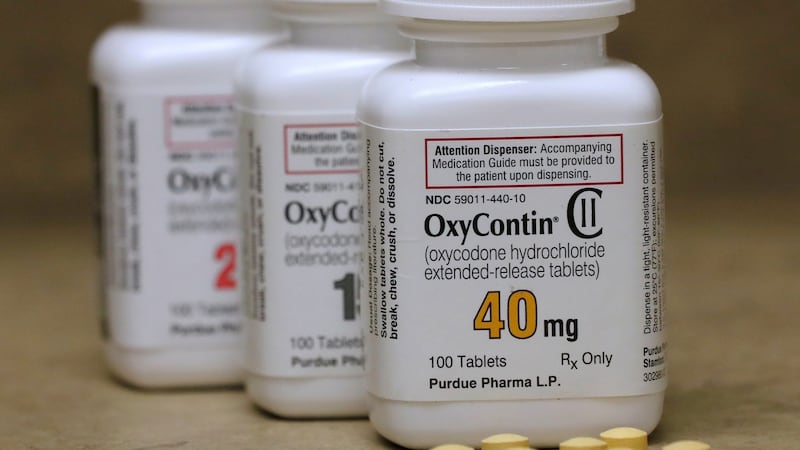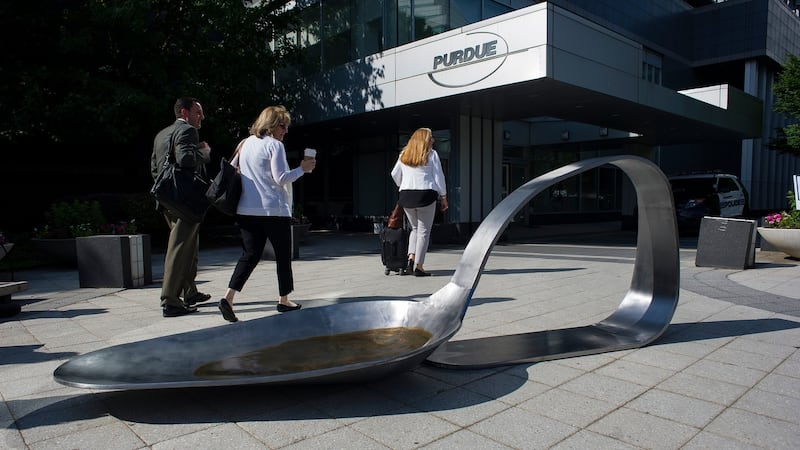Work crews are soon likely to be busy removing the name of the Sackler family from academic, medical and cultural buildings in various locations in the United States and across the world.
At the same time, lawyers will be at work in erasing the family from the titles of scholarships and fellowship programmes they have endowed.
For years universities, museums and other institutions accepted tens of millions of dollars from the billionaire Sackler family, owners of Purdue Pharma, the manufacturer of the prescription painkiller OxyContin.
However, the company faced widespread allegations that it had fuelled the opioid epidemic in the United States by aggressively marketing the drug while downplaying the prospects of patients becoming addicted.
Purdue is alleged to have knowingly misled doctors about how addictive OxyContin was, causing many patients to become hooked on opioids
In 2019, it sought bankruptcy protection as litigation against it piled up.
Purdue is alleged to have knowingly misled doctors about how addictive OxyContin was, causing many patients to become hooked on opioids. Some patients later turned to illegal drugs such as heroin, sometimes laced with dangerously potent fentanyl, causing even greater damage.

Overdose deaths have increased in the US in recent years, with more than 100,000 in 2021. The US Center for Disease Control and Prevention estimates that about 75 per cent of these involved an opioid drug.
Last month, a federal appeals court in New York cleared the way for a bankruptcy deal which would see the Sackler dynasty pay out up to $6 billion and lose control of the company. As part of the arrangement, the family had to listen to stories of those whose lives were affected by the drug manufactured by their company.
Shielded from claims
But in a controversial move, the Sacklers will be shielded from all future civil claims in relation to OxyContin.
As part of the bankruptcy settlement plan, the family must allow academic, medical and cultural institutions which received funding under its philanthropy programmes to remove the Sackler name from their facilities. This will be on condition that the Sacklers are notified of the move and any announcement regarding the renaming does not “disparage” the family.
Some institutions already have begun eradicating public links with the Sacklers.
Last year, the Solomon R Guggenheim Museum in New York removed the family name from an arts education centre, and the Louvre in Paris dropped it from a 12-room wing.
While the total overall payout seems enormous, the amount which will go to individuals is likely to be relatively small given the number of cases.
The New York Times reported last week that about 138,000 people had filed legal claims. It and other media suggested that payments were expected to range from about $3,500 to $48,000
About $750 million will go to people across the US who became addicted to OxyContin and to the families of those who died from overdoses.
The New York Times reported last week that about 138,000 people had filed legal claims. It and other media suggested that payments were expected to range from about $3,500 to $48,000. They said guardians of about 6,550 children with a history of neonatal abstinence syndrome may each receive about $7,000.
States, cities and other local authorities will benefit from a fund of several billion dollars. Much of this is likely to be used to tackle the overall opioid crisis with the introduction of new treatment and prevention programmes.
Federally recognised native American tribes will also receive funding from a trust of about $160 million established under the settlement.
‘Worth $11 billion’
Despite all this, the Sackler family will not be left in poverty.
An investigation by the US House of Representatives oversight committee in 2021 indicated that members of the family, “who have owned a controlling share of Purdue Pharma since 1952, are collectively worth a total of $11 billion”.
Payments are also expected to be spread out over a number of years.
A key issue at the heart of the case was whether a bankruptcy judge had the authority to prevent on a permanent basis plaintiffs from taking legal action against the owners of a company who had not themselves sought personal bankruptcy protection.
Different legal circuits in the United States had different and conflicting judgments on this issue.

Last month’s ruling was made by the United States Court of Appeals for the Second Circuit which covers New York, Connecticut and Vermont.
The Second Circuit Court of Appeals had spent more than a year reviewing the case after a lower court ruled it was not correct for Purdue Pharma’s bankruptcy deal to prevent future opioid-related lawsuits against the Sackler family.
The majority opinion of the court was that the legal claims against Purdue were inextricably linked to claims against its owners, and allowing lawsuits to continue targeting the Sacklers would undermine Purdue’s efforts to reach a bankruptcy settlement.
Legal protections
There is no indication that any members of the family will face criminal action. The Sackler family had made clear that an extension of the company’s legal protections to cover it had to form part of any overall agreement.
While the ruling to shield the family may appear controversial, some of the individual taking legal actions against the Sacklers were anxious to get their money.
The Sackler family had not been on the board of Purdue Pharma since 2018. Once the bankruptcy deal goes into effect, they will no longer own the company
However there are still a few hurdles to be jumped before individuals or states will see any payments.
The bankruptcy plan will have to go back to a federal district court judge and finally to the US bankruptcy court in New York for final approval.
[ Empire of Pain: America’s opioid crisis and the family behind itOpens in new window ]
[ Sacklers withdrew over €9bn from Purdue while opioid crisis eruptedOpens in new window ]
The Sackler family had not been on the board of Purdue Pharma since 2018. Once the bankruptcy deal goes into effect, they will no longer own the company.
Purdue itself will no longer exist as part of a future restructuring under the deal. It will become a new company known as Knoa, which will be committed to developing and distributing overdose reversal and addiction treatment medicines for no profit.
The overall settlement, once agreed, will likely mark the close of litigation regarding this element of the US opioid crisis.
The families of now-deceased Mortimer and Raymond Sackler, the two founders of Purdue Pharma, welcomed the court‘s decision.
“The Sackler families believe the long-awaited implementation of this resolution is critical to providing substantial resources for people and communities in need,” they said in a statement.



















